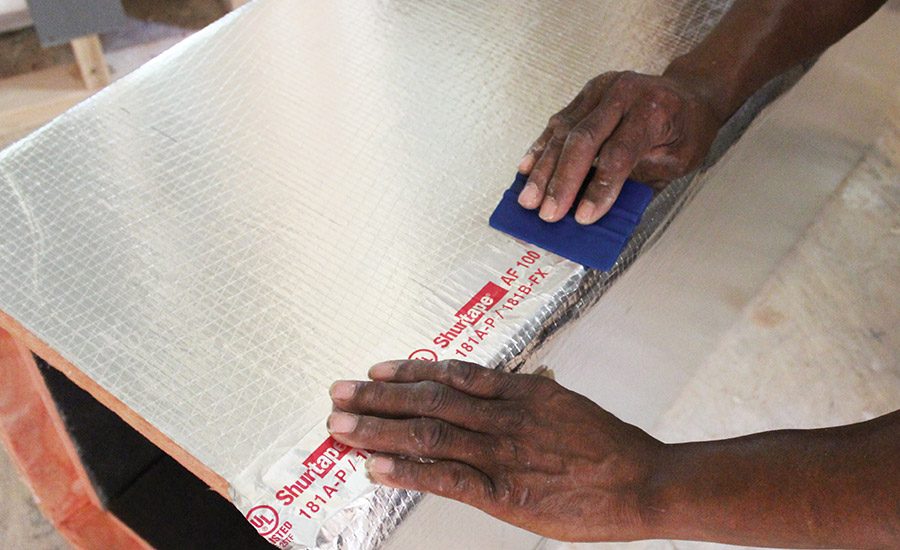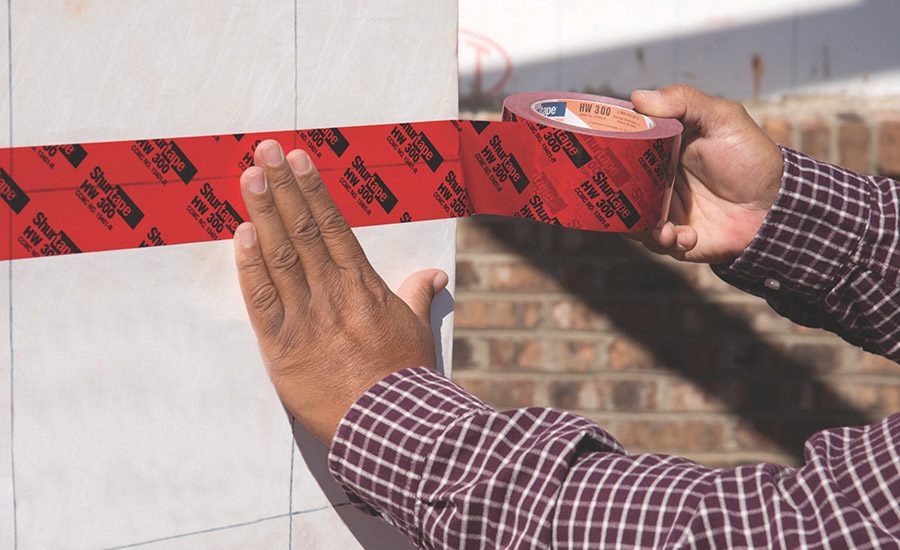Conscious Construction: An Evolution Toward Sustainability and Efficiency
Tapes are a critical component for many jobs throughout the construction of residential and commercial buildings.


UL-listed tapes are put through rigorous testing to ensure the products will perform under duress and can withstand the thermal cycling of HVAC systems.

Tape is used to seal the seams of housewrap, as well as the seams between individual pieces of insulating and non-insulating board stock.



Look around any growing city, and it’s easy to see many types of buildings in various stages of construction. The tools and materials used today vary greatly from those used in the most primitive forms of construction, but the result is the same—a structure is designed and built to keep the inhabitants protected from the elements while providing a comfortable environment for them to live and work in.
The first signs of “construction” have been dated to the Neolithic period (the last part of the Stone Age), roughly 12,000 years ago. Structures were built from stone, wood, and mud, with a single “door” that was usually found at one end of the structure. An opening was sometimes created at the top of the structure so smoke could escape, but not every dwelling had one.
Compare that type of structure to the skyscrapers, mansions, and tiny homes of today, and it’s clear—construction has come a long way in terms of the designs, materials, and methods used for building. That journey has not always been smooth sailing, though. Manufacturers, suppliers, and consumers of products used in the building and construction industry today need to consider many more factors than the Stone Age builder did.
Local and national building codes, sustainability initiatives, and other factors must be considered by today’s builders. Buildings are now thought of as systems, and each component of that system (e.g., walls, windows, HVAC, roof, and more) is intended to be durable and long-lasting. In fact, many components even have 20-year-plus guarantees if they’re properly installed according to the manufacturer’s instructions.
However, this was not always the case. Prior to 1915, codes existed that were specific to certain cities or countries, but none of them were on a national level—at least not in the U.S. Therefore, any materials could be used during any part of the construction process. If the building had a leaky roof after the first hard rain or mold started to grow on the walls after a few years, it was tough luck for the building owner and very few (if any) repercussions for the builder.
Fast forward to today: If any component used on a building system fails, a legal brawl is likely to ensue. That’s why it’s so critical to make sure the right materials are used in the right applications. It would take several thousand pages to talk about the changes to all the materials used in construction, so the focus here will be on tape as just one example of the many tools used on construction sites today.
Tape as a Tool
During the construction of a residential or commercial building, tape is a critical component for many jobs, such as installing HVAC systems, seaming housewrap, and hanging poly-sheeting. Tape is used to mark off dangerous areas, outline the footprint of the building, and indicate where utility lines will be placed. Despite its many uses, tape is often thought of as an add-on purchase, but many jobs can’t be started unless tape is on the jobsite.
One of the most common tapes to find on a construction project is duct tape. Invented in the 1940s, duct tape was originally used by the armed forces, primarily to help waterproof their ammunition cases. After WWII ended, duct tape was viewed as a potential solution for sealing ductwork because the rubber-based adhesives used on most duct tapes have excellent tack, while the cloth backing makes the tape flexible to conform to irregular shapes and surfaces.
As the lifespan of HVAC systems improved, however, the duct tape would oftentimes begin to fail and fall apart because it was not robust enough to withstand the systems’ multiple thermal cycles. This is when aluminum foil tapes entered the picture. In the 1940s and 50s, aluminum foil tape was used to wrap and protect packages, electrical capacitors, and more. It quickly became an alternative solution to duct tape for HVAC systems since the acrylic adhesive systems used on many foil tapes were well-suited to withstand the numerous thermal cycles an HVAC system endures during its lifespan.
Today, several types of tape (foil, film, and cloth) are designed specifically for sealing ductwork. These tapes all carry at least one UL listing, depending on the type of ductwork (rigid or flexible) they will be used on.
Abiding by HVAC Codes
It’s critical to use the correct UL-listed tape when sealing a duct system. Due to the numerous building codes now in existence, inspectors can fail jobs if a non-UL-listed tape is used. UL-listed tapes are printed with the applicable listing—UL 181A-P or UL 181B-FX—so they are easily identifiable:
- UL 181A-P listings are assigned to pressure-sensitive aluminum foil tapes that are intended to be used on rigid fiberglass duct board.
- UL 181B-FX listings are assigned to pressure-sensitive tapes that are intended to be used on Class 1 Flex duct. UL 181B-FX tapes do not need to use aluminum foil as their backing; they can be manufactured with cloth, film, or other materials.
Most tape manufacturers have a foil tape that is both UL 181A-P and UL 181B-FX listed. Mastic tapes can also be UL listed, falling under the UL 181B-FX category.
UL-listed tapes are put through rigorous testing to ensure the products will perform under duress and can withstand the thermal cycling of HVAC systems. Unlike duct tapes used for crafts or plain foil tapes used for temporary repairs, UL-listed tapes are designed to last for the lifetime of the system.
These tapes are an integral part of the larger HVAC system and help protect the system against air leaks. Achieving full system closure (i.e., a system with no leaks) is critical in HVAC systems. The inspector can fail the system if it allows too much air to escape and receives a poor air leakage rating, causing the contractor to have to redo their work.
Sealing the Building Envelope
As general consensus continues to shift away from the belief that building envelope materials are best fastened mechanically, other tapes (e.g., housewrap and flashing tapes) are increasingly being used for various applications during the building envelope installation. The building envelope consists of several different components (fenestration, ceilings, walls, floors, slab, and crawl space) that all help serve the purpose of creating and maintaining a barrier between the conditioned space and the exterior elements.
A building envelope serves several purposes, including: controlling heat, air, and water vapor flow; protecting against rain and ground water; and providing strength and durability to the overall structure. In short, the building envelope is a complex defense system designed to protect the conditioned space from all types of exterior threats.
Tape is an integral part of this defense system. It’s used to seal the seams of housewrap, as well as the seams between individual pieces of insulating and non-insulating board stock. It must adhere well to many types of substrates and remain fully adhered, even in extreme temperatures. As a result, the tapes used in these applications often have acrylic adhesive systems, which perform well across a broad temperature range and will still “wet out” on the surface they’re being applied to, even at freezing temperatures. Rubber-based adhesives tend to become dry and brittle once the temperature reaches below freezing. They can also become unstable at high temperatures, which may lead to undesired “flow out” issues that result in loss of adhesion and potential tape failure.
Tape is also used around windows and doors; in this application, it is generally referred to as flashing tape. Flashing tapes can be made with foil, film, or cloth backings; they typically have a fairly thick layer of adhesive and are designed to be extremely conformable. Some flashing tapes act as a water vapor barrier, which is important if the local code calls for continuous insulation around the building. Different methods can be used to apply flashing tape, but the ultimate goal is always the same: to protect the edges of the opening from water and use the tape to help direct the water to flow down and out from the edges of the door or window.
In addition to protecting the structure against the elements, a properly installed building envelope increases the efficiency of the structure by reducing the impact of unfavorable environmental factors, such as conditioned air escaping outside or water not draining away from the structure properly. A properly installed and sealed HVAC system works in conjunction with the building envelope system to reduce the impact of those unfavorable environmental factors.
Versatility and Dependability
Regardless of the application, tape is a critical tool to have on any construction site. While tape is easily overlooked, as most of the attention is usually focused on the larger materials needed to complete the job, its versatility and ease of use make it one of the most dependable tools on the jobsite—earning it a well-deserved place in every toolbox.
For more information, contact the author at (828) 267-8486 or lzierfuss@shurtape.com, or visit www.shurtape.com.
Looking for a reprint of this article?
From high-res PDFs to custom plaques, order your copy today!








